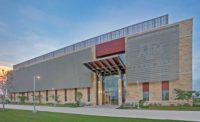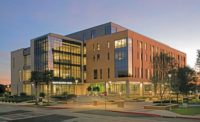...certification. The building also incorporates energy-efficient mechanical systems; locally produced, green materials; four above-ground, 8,000-gallon cisterns; and a bioswale to clean water before it seeps into the ground.

“The primary goal of the water collection was to collect every drop of rain, clean it and keep it or use it for irrigation,” Good says. “You can see the rain pour from the roof to the canopy. It’s meant to be an educational element on a grand scale.” Good considers the visitor center and museum the most interesting element of the complex, because it features not just the history of architecture but also new technologies and the future of the industry. The design concept creates simple structures that have a strong connection to the land and at the same time conform to the TAMU master plan. Skanska collaborated with the design team during preconstruction to ensure the best pricing and brought in early the electrical and mechanical, plumbing subcontractors—Brit Rice Electric in College Station and Lochridge Priest of Waco, respectively—to lock down prices.
Texas limestone will clad the first level. The next three are face brick, and the top level sports metal panels. The project is scheduled for completion in 2011.
Continued growth in higher education
Higher education remains one of the brighter market segments throughout Texas.
“Enrollment in Texas at the university and community college level is strong,” says Glenn Anderson, director of education for Turner Construction Co.’s Texas operation in Dallas. “University work we find is better than one year ago.”
Turner, with joint venture partner Con-Real of Arlington, is building the New Academic Wing & Laboratories at the Tarrant County College District’s Southeast Campus in Arlington, designed by SHW Group of Austin. The company, in association with Dikita Engineering of Dallas, also provides program management services for the Texas A&M University System, overseeing $350 million in projects, and Stephen F. Austin State University in Huntsville, assisting in the management of an $80-million program.
“If you look at the projects for the next five years, higher education is going to continue to grow,” says Kamal Ariss, vice president of JE Dunn Construction in Houston, which recently completed the $86-million, 219,000-sq-ft Interdisciplinary Life Science Building at TAMU.
“Funding is tougher than what it has been, but we continue to see programs coming out, maybe not quite as many or as large,” Daniel says.
Jeff Bricker, senior vice president of PageSoutherlandPage in Houston, says the Legislature provided little money for capital projects during the last session, and so funding for some projects is coming from the federal Build America Bond program, part of the American Recovery and Reinvestment Act of 2009.
Rex Carpenter, associate principal with HKS in Dallas, says the federal bill has funded some university work, but “we’ve seen some projects dry up that they thought were going to be stimulus funded.”
HKS designed an eight-story vertical campus for Texas Women’s University’s nursing and allied health programs in Dallas. Austin Commercial of Dallas is building the project, which came in 20% under the $55-million budget.
“What we’re seeing in the marketplace is everyone is trying to do more with less and get it done quickly,” Carpenter says.
Anderson does not expect tuition revenue bond funds will likely return until 2011, yet he agrees that the market has stayed strong anyway.
Some institutions had money from previous year’s budgets, Daniel says. And those that have the dollars to proceed are finding good pricing.
Skanska’s Daniel agrees that “where there is money, there is lots of interest in getting things moving, such as what we saw with the Ag building.”
The economic slump had prompted TAMU to place the entire project Agriculture Headquarters on hold in January 2009, but Skanska revisited its guaranteed maximum price and found that by starting construction last spring, the school could save about $6 million as a result of lower subcontracting costs.
“They were able to get more building for the same amount of money,” Daniel says. “Texas A&M took advantage of that timing.”
In addition to the university work, community colleges, which raise money from county property taxes and local bond referendums, are building to handle greater demand. Bricker and Anderson explain that community colleges raise money from county property taxes and local bond referendums.
Even so, those projects also must be approved by the Texas Higher Education Coordinating Board, which seeks to ensure construction projects meet the overall state education goals and that schools serving the same geographic area are not competing. PageSoutherlandPage designed the recently completed $30-million, 150,000-sq-ft classroom building for the University of Houston Sugar Land and Wharton County Junior College, built by Skanska.
Continuing with master planning “Expenditures around master planning are small compared to building,” says Carpenter, adding his firm recently picked up four master plan contracts. “Universities with significant five- or 10-year plans have hiccups. We’re seeing universities looking with more interest at how to reuse existing buildings that were going to go away before the economic downturn.”
Daniel says university projects that can generate revenue, such as performing arts centers, are moving forward because the income produced helps make the economics work.
Anderson adds that sports facilities, student centers and housing continue to remain strong.
“We’re also seeing sports and athletic activity,” Carpenter says. “Facilities are updating or adding seats. As colleges are around longer, there are more alumni and it’s more difficult to get football tickets. There are a few bright spots.”


